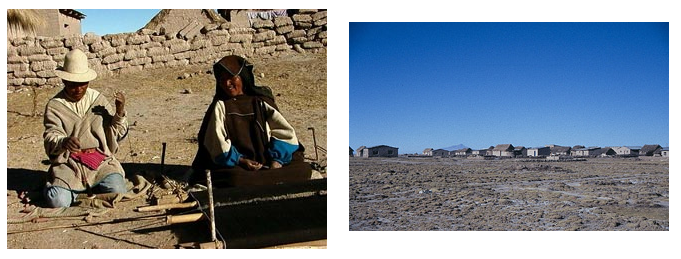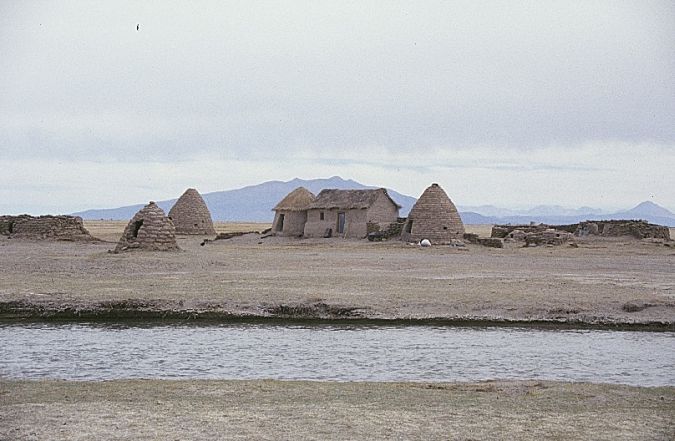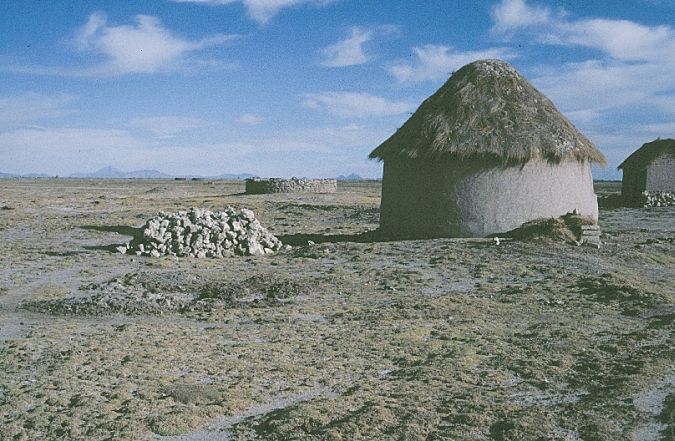Information
Chipaya is spoken by about 1800 people in Bolivia. Most of them live north of Lake Coipasa in the department Oruro. Chipaya belongs to the Uru-Chipaya group of languages. The speakers of Chipaya know that their language is endangered and try to preserve it. They have established a language committee, who created a writing system for Chipaya in 2002 in order to have the language taught in schools.
Further information and resourses:
DoBeS Chipaya project: http://www.mpi.nl/DOBES/projects/chipaya. This site contains information on the language and the people, their history and culture as well as on the geography of the area. Short information in Spanish and English on the site "Lenguas de Bolivia" at http://www.ru.nl/lenguassp/lenguas-de-bolivia/presentacion/Pictures
The Chipaya people and the landscape in which they live have fascinated also professional photographers. Here are two galleries worth watching:Teaching material:
Discuss:
1) What could be the reasons why these words were borrowed from Spanish into Chipaya?2) Does the high amount of Spanish loanwords displayed in this text represent a danger to Chipaya? Why (not)?
Does the influence of Spanish on the language reflect an influence on the culture of the speakers?
Suggestions for teachers:
The greatest part of the borrowed words in this text are names of vegetables. A reason for borrowing these words might be that the respective plants are not native, but have been introduced by the colonists. These words are phonetically well integrated, probably the speakers of Chipaya have adopted them as Chipaya words. In this way, these words are no danger for the language. On the other hand, the fact that most ingrediants of a traditional dish have borrowed names shows a high degree of cultural influence.The word recetal 'recipe' seems to be less well integrated , which may show that it has been borrowed more recently. It may have replaced a native word, but it is also possible that the genre "recipe" is not a traditional genre (you learn how to cook by watching others and taking part in the process, not by formal instruction). In the latter case we can again see a cultural influence, the introduction of new speech genres.
The use of the Spanish adverb or discourse particle acqui in line 5 may show that the speaker is bilingual. Such words are easily taken over from one language to another .
Audio
Fragment of Chipaya mytho-history, told by an elderly man from Santa Ana de Chipaya.
Recorded, transcribed and translated by Sabine Dedenbach-Salazar Sáenz
Find comments and a summary of the whole story at http://www.mpi.nl/DOBES/projects/chipaya/data
| Chipaya | English |
|---|---|
| 1. bueno werh tshi k'int'asaćha tukita timpu mathñillaź qamta | 1. Well, I will tell a story of the lives of the ancestors. |
| 2. tukit tuki timpuki ti chipay wathak tiw ana źelatćha khićha | 2. In very ancient times this village of Chipaya did not exist here, they say. |
| 3. wathaki nawkh uźa kapilla perdida khita xalla niwkhutakiź wathaki | 3. The village was in the north, where the Lost Chapel is, it is said. So there was the village. |
| 4. neqhśtan teqhś tshi qota źelatkiź | 4. Then there was a lake here. |
| 5. teqhśi tï ti thïkiś qota paqh qota | 5. Here - this, this - by the shore was a lake, a big lake. |
| 6. neqhś ch'iśnaka weślanaka śiñinaka źelatź | 6. There were fish, birds, eggs. |
| 7. xalla nikhtan niwkh chipay źonakak thonchikiź tiwk ch'iśtani weźla koni | 7. Then, from there the Chipaya people came there [sic] it is said; in order to fish and to kill birds here. |
| 8. neqhśtan uźaśaqś qaqhćhan kapilla perdida khita xalla niwkhu | 8. Then they probably also went back north to the Lost Chapel, it is said, so there [they went]. |
| 9. neqhśtan aźkinpacha xayraśśiki ninaka ni źonaka neqhś tshi qhuya qhuychikiź teqhś tshi qhuyalla | 9. Then that was very far away; they got tired; so they, the people built a house over there, a small house. |
| 10. ni qhuyalla ch'ipha khitatakiźni | 10. That little house must have been called Ch'ipha. |
| 11. neqhśtan tshi warkuśaqś phitkiśtan pächitakiź xalla ni qota luśśapa xalla neqhś ni qhuyallkiś ekñitakiź ni warku | 11. Then, they also made a boat of straw / so they could enter the lake / so over there in the little house they used to leave the boat. |
| 12. xalla neqhśtan iya niźta oqhlaychi oqhlaychi hasta ni kapilla perdidkiśtan q'ala tiwk thoñchikiź ti wathkiś ti ch'ipha wathkiś | 12. Thus then they walked and walked more, until from the Lost Chapel they came exactly here, to this village, to this Chi'pha village, it is said. |
| 13. neqhś wakchi qhuyanaka qhuychikiź | 13. Over there they built many houses; |
| 14. hasta ana ni kapilla perdida ana niwk oqhchikiź ekchikiź | 14. then they did not go [back] there, not to the Lost Chapel; they left it. |
| 15. xalla neqhś ni wiri wiriñ hasta teqhś mirćhan źonakaki | 15. So then gradually, until now, they must have multiplied – the people. |
| 16. xalla neqhśtan ni ch'ipha khita qhuyallak hasta wathapachallaźlan | 16. So then that what was called the Ch'ipha was a little house, [and] then it has become a whole village. |
| 17. neqhśtanak oltimkiś chipaya xalla nuź thutźtaźni xalla neqhśtan anś chipaya ti wathak anś | 17. Afterwards, in the end it must have become Chipaya; so then, now this village is Chipaya. |
| 18. nuźkhita thüchiś ti wathak chipaya piramira ch'iphataź khiź tik ch'ipha | 18. Then this village was called Chipaya; first, it is said, it had been called Ch'ipha. |
| 19. nuźuź ni tukita kintuki | 19. Thus is the tale of the old times. |
Photo
Photographs by courtesy of Katja Hanß



Exercise
A speaker of Chipaya tells a recipe for quinoa soup. In this fragment (the first minute) we find many words that have been taken over from Spanish. Can you find these loanwords?
1) Read the free English translation and make guesses which words will be Spanish loanwords in Chipaya:
"Now I will relate a recipe for quinoa soup. Here, for four persons: one onion, one carrot, one medium handful of peeled peas or beans, a bit of parsley and one or two small turnips."
2) Now try to identify the loanwords in the Chipaya text. There are 9 loanwords in the fragment.
First, by listening to the recording alone
Second, by reading the transcription and the literal English translation.
Third, by comparing the transcription with the Spanish equivalents of each word
| 1. werkhi teqhś | I here | 1. yo aqui |
| 2. kul resetal | a recipe for quinoa | 2. quinua receta |
| 3. paacha | I will do | 3. voy a hacer |
| 4. thsi taza thsi taza kulźtan, | one cup of quinoa | 4. una taza una taza con quinua |
| 5. neqhśtan aqui | then here | 5. despues acqui |
| 6. (niki paqhpik źonakźtaćha) | this will be for four persons | 6. (ese es para cuatro personas) |
| 7. śinta śipulla, thsi zanaroria | one onion, one carrot | 7. una cebolla, una zanhoria |
| 8. thsi ch'ulla qhora chhäpta alwerja o xawaśa | and one medium handful of peeled peas or beans | 8. una media mano de alverga pelada o habas |
| 9. xalla neqhśtan thsi koluk perigil | and then a bit of parsley | 9. y despues un poco peregil |
| 10. thsi phsik nawulla | one or two little turnips | 10. unos dos navitos |
Answer
Answer: Spanish loanwords: resetal ‘recipe’, taza ‘cup’, acqui ‘here’, śipulla ‘onion’, zanaroria ‘carrot’, alwerja ‘pea’, xawaśa ‘bean’, perigil ‘parsley’, nawulla (< nawa, Sp. nabo) ‘turnip’
